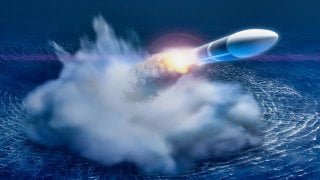China 'Flying Circles' Around U.S. Military in Hypersonic Weapons
China's military advancements, particularly in hypersonic weapons, are shifting the balance of power in the Indo-Pacific. China is enhancing its strategic capabilities by developing technologies like a new cooling device for hypersonic missiles and integrating 6G communications with laser systems.
Summary and Key Points You Need to Know: China's military advancements, particularly in hypersonic weapons, are shifting the balance of power in the Indo-Pacific. By developing technologies like a new cooling device for hypersonic missiles and integrating 6G communications with laser systems, China is enhancing its strategic capabilities.
-These developments challenge the U.S. military's ability to project power in the region, especially in a potential conflict over Taiwan.
-The U.S. once relied on superior technology and training, but China's rapid advancements could undermine these advantages, making it increasingly difficult for America to maintain its influence and counter Chinese ambitions in the Indo-Pacific
China's Hypersonic Advances: A Threat to U.S. Dominance in the Indo-Pacific
China has readied itself to defeat the United States in any coming conflict over control of the Indo-Pacific. China has effectively created a box around the South China Sea, Taiwan Strait, and East China Sea. Breaking it would come at a very high cost to the U.S. and its allies.
China has further focused on a strategy of active defense for their near-abroad. At the same time, Beijing is building a network of allies based not on shared values, but on strategic and economic interests.
China possesses more people than does the U.S., and the size of China’s military reflects this reality. The Americans and their allies rely upon superior technology, greater funding, and a better-trained military to serve as force multipliers designed to overcome the inherent advantages that China will have in any war – in particular, the proximity of conflict to Chinese territory.
China is Going to Beat America at This Rate
China has consistently proven it can now match and sometimes surpass the technological advantages the Americans feel they have. Further, China is now funding their military at a greater clip than ever before, and the projects they are funding fit a strategic vision.
One technological domain where the Chinese are flying circles around their potential American rivals in war is in the hypersonic weapons arena. A report from Interesting Engineering, a popular engineering publication, details how scientists at China’s National University of Defense Technology’s College of Aerospace and Engineering “claim to have developed a new cooling device for hypersonic missiles.” The report goes on to explain that “the new cooling device can improve the hypersonic missile’s flight time by nearly two and a half hours.”
That would mean a missile can hit its targets at speeds anywhere between Mach 7 and Mach 20, all while maneuvering in such a radical fashion that most air defense systems would have difficulty stopping the attack.
So, one could anticipate waking up to rapid, massive destruction at key targets, radically altering a battle away from the U.S. military’s advantages and toward those of China.
Another recent study in China suggests that by employing a “skip-gliding” technique in the upper atmosphere, a Chinese hypersonic glide vehicle can extend its range beyond the Indo-Pacific, possibly threatening even the mainland United States.
More Advances for China
As I reported two years ago, Chinese scientists made a considerable breakthrough by marrying their nascent sixth-generation (6G) internet advances with their growing laser capabilities to create a next-generation communications system that allows for greater control of hypersonic weapons.
Essentially, by beaming a 6G internet laser through the plasma bubble that forms around a hypersonic glide vehicle re-entering the Earth’s atmosphere at extreme speeds, Chinese controllers can have continuous access over that high-flying weapon from the moment it is launched all the way until the moment it passes over its intended target.
These systems alone will stunt whatever power projection capabilities the Americans have at their disposal today.
How It Will Impact the Strategic Balance
The last time the world teetered on a conflict between China and Taiwan was during the 1996 Taiwanese presidential elections. Back then, the Chinese government did not like the fact that Taiwan was set to elect a pro-independence politician as president.
To intimidate the Taiwanese voters, China subjected the nearby island democracy to a fusillade of seemingly endless rocket launches and other acts of belligerence. The Taiwanese were able to call upon their American allies to put an end to the threat.
Then-President Bill Clinton sailed U.S. aircraft carriers through the Taiwan Strait. There was little the Chinese military could do but watch. The crisis was averted. Taiwan was saved. World peace was maintained.
Twenty-eight years later, with the advent of increasingly sophisticated hypersonic weapons, along with other significant Chinese military capabilities when the Chinese decide to annex Taiwan (or simply strangle it via blockade), unless America rapidly develops next-generation technologies to counter those of China, then China will achieve its objectives in Taiwan.
As Donald Rumsfeld once quipped, “We are on notice. But we have not noticed.”
Author Experience and Expertise: Brandon J. Weichert
Brandon J. Weichert, a National Interest national security analyst, is a former Congressional staffer and geopolitical analyst who is a contributor at The Washington Times, the Asia Times, and The-Pipeline. He is the author of Winning Space: How America Remains a Superpower, Biohacked: China’s Race to Control Life, and The Shadow War: Iran’s Quest for Supremacy. His next book, A Disaster of Our Own Making: How the West Lost Ukraine, is due October 22 from Encounter Books. Weichert can be followed via Twitter @WeTheBrandon.
All images are Creative Commons or Shutterstock.
From the Vault
Russia Freaked Out: Why the U.S. Navy 'Unretired' the Iowa-Class Battleships
Battleship vs. Battlecruiser: Iowa-Class vs. Russia's Kirov-Class (Who Wins?)


